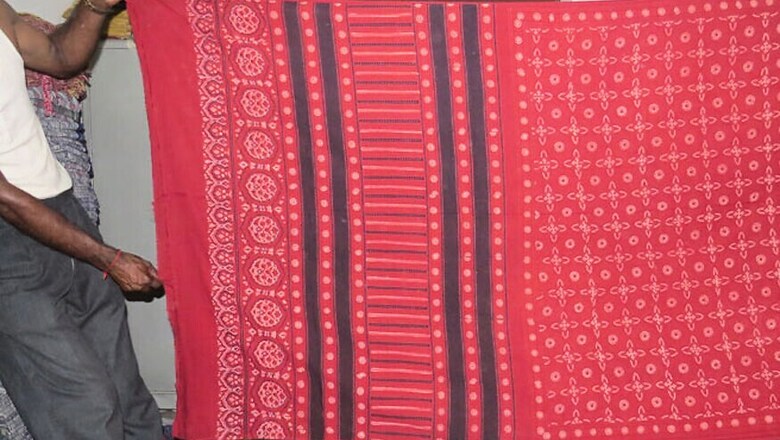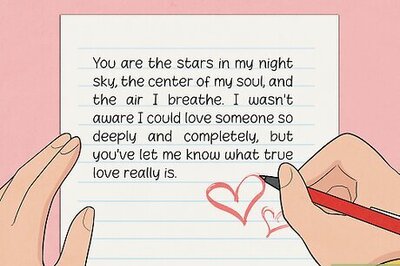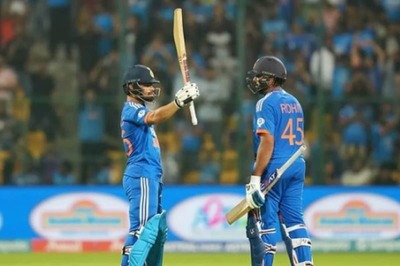
views
At a time when many traditional crafts are struggling to survive, Ajrakhpur -- a tiny village in the Kutch region of Gujarat -- is alluring domestic and international buyers with its beautiful natural-dyed, block-print cloth that is turned into exquisite garments and home furnishing.
Ajrakh, as the particular print is called, is the result of a long and laborious process that the 100-odd families in the village are involved in and which finally makes its way to the collection of top-notch fashion labels.
While Ajrakhpur, the village, in itself is not very old -- the artisans, led by the family of Sufiyan Ismail Khatri, shifted from a different village, Dhamadka, there after the devastating 2001 Bhuj earthquake -- their craft is more than 400 years old. Sufiyan, who is a ninth generation Ajrakh printer, traces his roots to the 16th century when his ancestors carried their craft here all the way from Sindh.
As the scorching sun beats upon the dry land in this western part of the country, the brown landscape suddenly starts getting dotted with sheets after sheets of colourful cloth, all dyed and block-printed, and laid out in the open to dry. Heavy stones are put at the four corners to keep the sheets from flying off.
"Traditional Ajrakh printing using natural dyes is a 16-stage process which takes anywhere between 14 to 21 days, depending on the number of colours and layers of block print designs used," Sufiyan said while explaining a particular design to one of his workers in the workshop.
The lengthy dyeing and printing process includes un-dyed fabric being first prepared by being torn into a particular length -- usually nine metres -- and being soaked in water overnight before being washed to remove the starch. It is then dried in the sun. After that, it is dyed with myrobalam and again put out in the sun.
From a collection that is maybe decades old, artisans then select a wooden block with traditional designs. The first block is coated with lime and acacia gum and carefully pressed onto the cloth at regular intervals -- an act termed the "resist".
"One of the main differences between Ajrakh and the block printing you find in Rajasthan is this 'resist' technique," Sufiyan told this correspondent.
Thenceforth, artisans continue selecting blocks, coating them with dyes and pressing them carefully on the cloth in a particular alignment. After each colour of print, the cloth is washed and sun-dried.
As the name suggests, the natural dyes are all sourced from nature. In fact, the name 'Ajrakh' is linked to the Arabic word for indigo, a blue plant which once thrived in the arid landscape of Kutch until the 1956 earthquake. But the popular story among artisans is that the name is derived from the phrase "aaj rakh", meaning "keep it for today".
It is very common to see scrap iron lying around workshops in Ajrakhpur. That is because the colour black is derived from a mixture of iron, jaggery and gram flour. The process, Ismail Anwar, another artisan of the village said, takes about 15 days and they make around 200 litres in one go.
Tamarind seed powder and alum makes red, turmeric makes yellow, and lime is used for white. "Traditionally, Ajrakh printing was only in natural colours, but because there is also a demand for cheaper variety, we also make clothes with pigment or artificial colours. Artificial colour printing is also faster -- printing a sari will take two days -- so it works well when there is heavy demand," Anwar explained.
Artificially coloured cloth can be priced at Rs 50-60 per metre; if the print is of an antique design, it can go up to Rs 100. Natural coloured cloth starts at Rs 70-75 per metre and with antique designs can go up to Rs 180.
It has not all been a colourful story for Ajrakh -- there have been difficult times, like when the artisan families had to move to their present address and put together all their resources to re-build their lives.
"But our craft is now in much demand. Designers like Tarun Tahliani have worked with me, and I have visited many countries, including the US, Australia, the Netherlands and Hungary, on invitation by designers to showcase our art and to learn from each other," Sufiyan said.
Between July and November this year, he is visiting 12 countries and is also working on a project "to revive the 400-year-old art linkages" with Thailand and the Netherlands.
Anwar similarly said he has received many students from design institutes to learn his craft. Most artisans also participate in exhibitions across India.
Even as hot winds blow through an April afternoon in Ajrakhpur, work does not come to a halt. "These summer months are the best time for our work," Anwar smiled.
Overlooking the work of his nephew in his workshop, he added: "Our craft is everything to us; it is passed down generations. Earlier, it was the nomadic pastorals like Ahirs and Rabaris who wore Ajrakh; now it's finding its presence in urban homes. People's love for Ajrakh is a big gift to us."




















Comments
0 comment